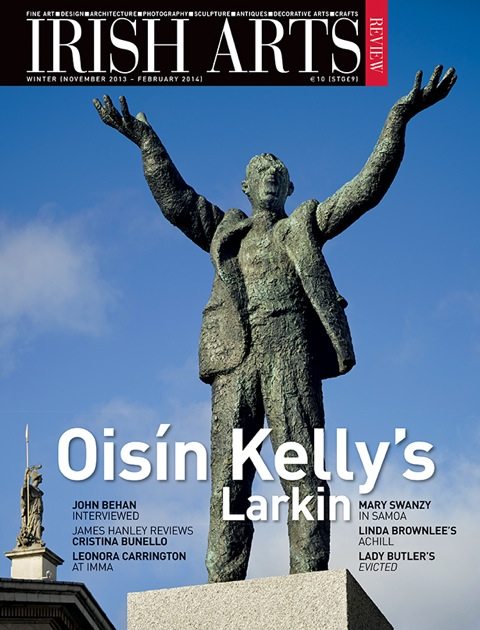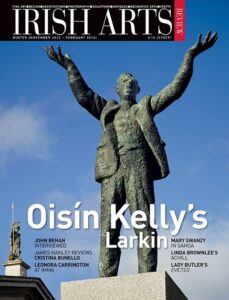

Eleanor Flegg visits ceramicist Mark Campden’s Kilkenny studio to witness the process behind his gleaming table-ware
Mark Campden’s new wood-fired kiln stands at the back of his studio with the aspect of a small, exquisitely crafted temple; a thing of beauty in itself, the building of which was a labour of love. It is, strictly speaking, the opposite of a labour-saving device and will add further layers of work to his process: the procurement and stacking of fuel, the stoking of fire-boxes, the risk and drama of firing his pieces a third time. Inevitably there will be losses. Disappointments are unavoidable. But it will give him lustre: the iridescent and shining forms of pond life echoing each other around his pieces under a layer of gold.
The new technique has softened the exactitude of his decoration, giving them a new fluidity of expression
Lustre, Campden insists, is a chemical process, but it is hard to avoid sounding arcane about a process that involves the transmutation of metals. The decorative technique evolved in 9th-century Mesopotamia and was a trade secret for centuries, its recipe eventually included in Abu’l Qasim’s deliciously named The Virtues of Jewels and the Delicacies of Perfume, a 14th-century work that described how silver and copper, painted onto glazed vessels which were then re-fired, produced a lustrous shine. As lustre filtered gradually west, via the Italian Renaissance, it aroused suspicions that the application of metals to a pot, which produced a golden surface when transformed by fire, might indeed involve alchemy. More recent studies, however, indicate that the metallic sheen of lustre is due to the dispersion of silver and copper nanoparticles through the surface of the glaze.
It is, by any measure, a risky and intensive process. ‘Normally when I make a pot and fire it, it’s finished,’ Campden says, ‘but the lustre is a third process. It involves painting metal compounds onto the glaze surface and then firing the pieces again at lower temperature so that the lustre attaches to the work.’ This third firing is a reduction firing: the kiln is stoked and the air supply reduced, starving the kiln of oxygen. ‘The metal atoms in the lustre pigment try to fuse with oxygen atoms and they can only do this at the glaze surface because there’s no more oxygen in the kiln,’ he explains.
This, for Campden, is where the excitement of making lies. His large plates are press-moulded, the smaller vessels thrown on the wheel, but although all elements of the form are integral to the work, he is less moved by the formation of the clay than by what happens after. His true interest lies in the decoration of surfaces, with which he engages on the molecular level with that particular emotional intensity characteristic of potters. And lustre, in a sense, is in his blood. Campden grew up in Aldermaston, where his father worked at the pottery established by Alan Caiger-Smith in 1955 and which Tanya Harrod describes as ‘a little classless paradise’ of co-operative teamwork where Caiger-Smith’s tin glaze majolica and lustreware stood out amongst the ‘the sober domestic stoneware pottery of the 1950s and 1960s’ (The Crafts in Britain in the 20th Century, p. 262). Although Campden is quick to acknowledge the chain of influence, there are also differences. Caiger-Smith’s brush-painted decoration was based on Far Eastern calligraphy, but Campden’s is drawn from the wildlife that surrounds his Co Kilkenny studio.
He has an interest in humble life forms. The walls and floor of his kitchen are interspersed with tiles hand painted with beetles and spiders, but he says, there is a limit to what people will tolerate on pots. Dragonflies pass muster, as do newts. He restrains himself from decorating pots with slugs and is currently interested in moths, although he tends to call them butterflies.
Campden now works in lustre as well as the tin-glazed earthenware for which he is best known, its patterning reflecting both the geometric influence of Islamic pottery and the inspiration of his own pond. The new technique has softened the exactitude of his decoration, giving them a new fluidity of expression. He sells work both through his own studio, The Bridge Pottery which he runs in partnership with Caroline Dolan, and MADE in Kilkenny, a collective of professional craftspeople who have gathered in the county and whose presence there reflects, to some regard, a continuity with the tradition of the Kilkenny Design Workshops (1965-1988).
Eleanor Flegg is a writer and craft historian living in Dublin.
From the IAR Archive
First published in the Irish Arts Review Vol 30, No 4, 2013



